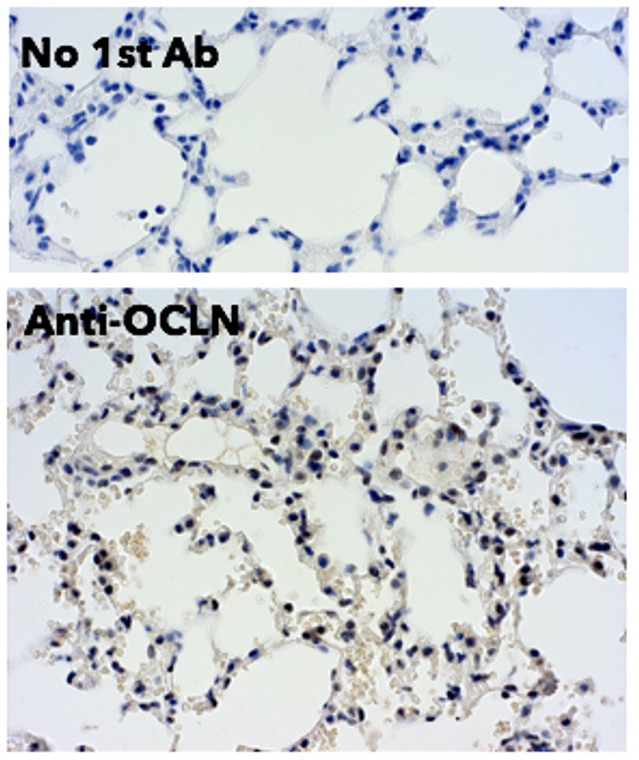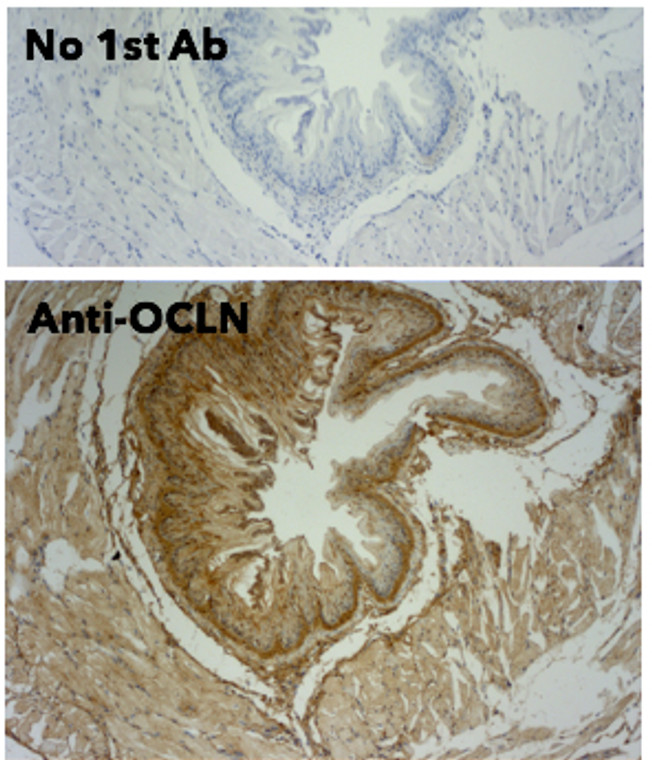| Host: |
Goat |
| Applications: |
WB/IHC-F/IHC-P |
| Reactivity: |
Human/Rat/Mouse/Monkey/Canine |
| Note: |
STRICTLY FOR FURTHER SCIENTIFIC RESEARCH USE ONLY (RUO). MUST NOT TO BE USED IN DIAGNOSTIC OR THERAPEUTIC APPLICATIONS. |
| Short Description: |
Goat polyclonal antibody anti-Occludin (500aa C-Term) is suitable for use in Western Blot, Immunohistochemistry and Immunohistochemistry research applications. |
| Clonality: |
Polyclonal |
| Conjugation: |
Unconjugated |
| Isotype: |
IgG |
| Formulation: |
PBS, 20% Glycerol and 0.05% Sodium Azide. |
| Purification: |
This antibody is epitope-affinity purified from goat antiserum. |
| Concentration: |
3 mg/ml |
| Dilution Range: |
WB 1:500-1:2000IHC-F 1:250-1:1000IHC-P 1:250-1:1000 |
| Storage Instruction: |
For continuous use, store at 2-8 C for one-two days. For extended storage, store in-20 C freezer. Working dilution samples should be discarded if not used within 12 hours. |
| Gene Symbol: |
OCLN |
| Gene ID: |
100506658 |
| Uniprot ID: |
OCLN_HUMAN |
| Immunogen Region: |
500aa C-Term |
| Accession Number: |
ENSG00000197822 |
| Specificity: |
Detects endogenous levels of OCLN in MCR, IMCD3, COS7, MDCK, HUH, HEK293, MCF7, mouse brain by Western blot. |
| Immunogen: |
Peptide derived from within residues 500 aa to the C-terminus of human Occludin. |
| Tissue Specificity | Localized at tight junctions of both epithelial and endothelial cells. Highly expressed in kidney. Not detected in testis. |
| Post Translational Modifications | Dephosphorylated by PTPRJ. The tyrosine phosphorylation on Tyr-398 and Tyr-402 reduces its ability to interact with TJP1. Phosphorylation at Ser-490 also attenuates the interaction with TJP1. (Microbial infection) Cleaved by S.pyogenes SpeB protease.leading to its degradation. Degradation by SpeB promotes bacterial translocation across the host epithelial barrier. |
| Function | May play a role in the formation and regulation of the tight junction (TJ) paracellular permeability barrier. It is able to induce adhesion when expressed in cells lacking tight junctions. (Microbial infection) Acts as a coreceptor for hepatitis C virus (HCV) in hepatocytes. |
| Protein Name | Occludin |
| Database Links | Reactome: R-HSA-351906Reactome: R-HSA-8935964 |
| Cellular Localisation | Cell MembraneMulti-Pass Membrane ProteinCell JunctionTight Junction |
| Alternative Antibody Names | Anti-Occludin antibodyAnti-OCLN antibody |
Information sourced from Uniprot.org
12 months for antibodies. 6 months for ELISA Kits. Please see website T&Cs for further guidance














